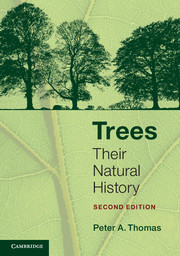Book contents
- Frontmatter
- Epigraph
- Contents
- Preface
- Chapter 1 An overview
- Chapter 2 Leaves: the food producers
- Chapter 3 The trunk and branches: more than a connecting drainpipe
- Chapter 4 Roots: the hidden tree
- Chapter 5 Towards the next generation: flowers, fruits and seeds
- Chapter 6 The growing tree
- Chapter 7 The shape of trees
- Chapter 8 The next generation: new trees from old
- Chapter 9 Age, health, damage and death: living in a hostile world
- Chapter 10 Trees and us
- Further Reading
- Index
- References
Chapter 7 - The shape of trees
Published online by Cambridge University Press: 05 July 2014
- Frontmatter
- Epigraph
- Contents
- Preface
- Chapter 1 An overview
- Chapter 2 Leaves: the food producers
- Chapter 3 The trunk and branches: more than a connecting drainpipe
- Chapter 4 Roots: the hidden tree
- Chapter 5 Towards the next generation: flowers, fruits and seeds
- Chapter 6 The growing tree
- Chapter 7 The shape of trees
- Chapter 8 The next generation: new trees from old
- Chapter 9 Age, health, damage and death: living in a hostile world
- Chapter 10 Trees and us
- Further Reading
- Index
- References
Summary
The whole point of a woody skeleton is ultimately to get the leaves above competitors to ensure a lion’s share of the light. And from this simple goal comes an enormous range of tree shapes, from the unbranched stems of palms and tree ferns to the tall spires of conifers, the broad spreading crown of oaks and the multiple stems of an old yew. What governs the shape of trees? How are trees organised to display what often looks like an impossibly large number of leaves?
Trees of distinctive shape
It is usually possible (but not always!) to identify a conifer from a distance by its conical outline. Within the cone there are usually horizontal plates of foliage showing where the branches are produced in whorls around the main stem, usually one whorl per year (Figure 7.1). This contrasts with the wide dome of a hardwood where the leading shoot of the young tree gives way to a number of strong branches giving the whole canopy a rounded shape.
Within these two main shapes it is possible (with a little practice) to distinguish different species simply by their shape. This book is not the place to list the distinctive features of common species but one example will illustrate the point. In common lime (Tilia x europaea) the main branches develop in great arching curves which in time lose the terminal buds. New growth comes from near the top of the branch end resulting in another arch, creating the effect of multiple rainbows joined together at their ends (Figure 7.2). Also, epicormic buds (Chapter 3) characteristically produce a mass of sprouts around the base of the trunk and frequently a congested growth of small twigs in the centre of the canopy. Some of these young growths escape to produce vertical branches through the crown, parallel to the main stem.
- Type
- Chapter
- Information
- TreesTheir Natural History, pp. 245 - 283Publisher: Cambridge University PressPrint publication year: 2014

